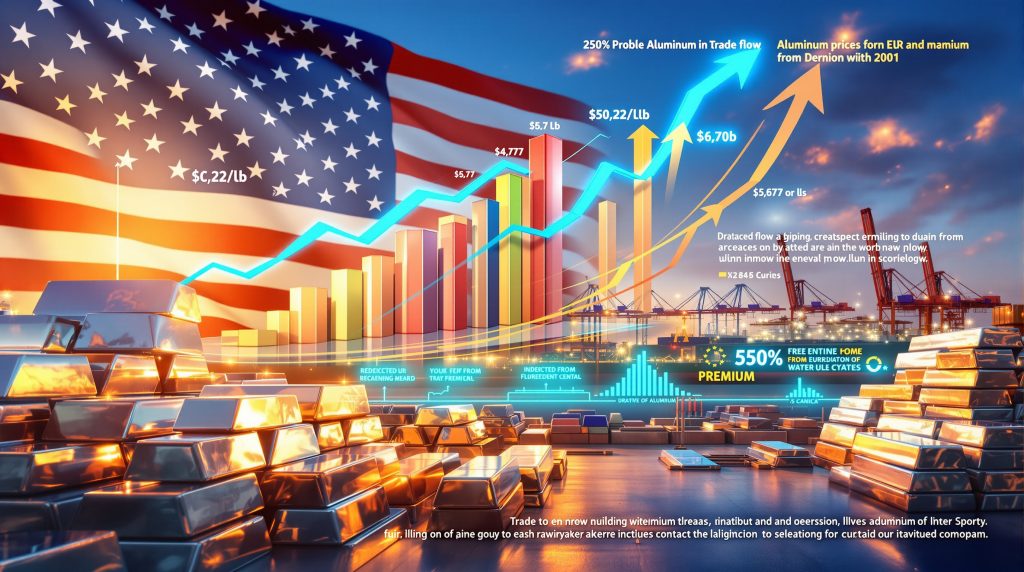Understanding the Current Aluminum Tariff Landscape
The LME Week US aluminum tariff impact has become a defining factor in global metals markets since President Donald Trump implemented a 50% Section 232 tariff on aluminum imports in June 2025. This aggressive trade policy targeted what the administration deemed a national security threat, fundamentally altering trade dynamics and creating unprecedented market conditions.
Canada, historically the dominant supplier with 2.7 million metric tons delivered in 2024 representing 70% of total US aluminum imports, found itself at the epicenter of this trade disruption. The Section 232 authority, which grants presidential power to impose import restrictions on goods classified as national security threats, became the legal framework for these unprecedented tariff levels.
The implementation timeline reveals the swift nature of policy execution, with tariffs taking effect immediately upon announcement in June 2025. Unlike gradual phase-ins common with other trade measures, the aluminum tariffs created instant market disruption, forcing immediate strategic recalibrations across North American supply chains.
Industry analysts note that the tariff structure operates as both a protective barrier and a revenue mechanism. However, the primary stated objective focuses on boosting domestic aluminum production capacity rather than generating customs revenue. This policy approach represents a departure from traditional trade remedy mechanisms, utilising national security justifications to achieve industrial policy goals. Furthermore, our comprehensive tariffs impact analysis reveals how these measures ripple through investment markets.
What Impact Have Tariffs Had on US Aluminum Pricing?
The pricing revolution in US aluminum markets has been nothing short of dramatic, with the Midwest premium reaching an unprecedented $0.77 per pound ($1,697 per ton) on October 6, 2025. This represents a staggering 250% increase since January 2025, fundamentally reshaping cost structures across aluminum-dependent industries.
Understanding aluminum pricing mechanics reveals why these premiums matter so significantly. Physical aluminum buyers must pay the London Metal Exchange (LME) benchmark price, approximately $2,750 per ton as of mid-October 2025, plus regional premiums covering logistics, market conditions, taxes, freight, and handling costs. Moreover, the US tariff inflation impact demonstrates how these price increases contribute to broader inflationary pressures across the economy.
| Period | Midwest Premium | Percentage Change | Key Market Drivers |
|---|---|---|---|
| January 2025 | ~$0.31/lb | Baseline | Pre-tariff market conditions |
| June 2025 | ~$0.45/lb | +45% | Initial tariff implementation shock |
| October 2025 | $0.77/lb | +148% | Inventory depletion and supply constraints |
David Wilson, analyst at BNP Paribas, observed that the US Midwest premium effectively represents full pricing of the 50% tariff structure. This pricing dynamic demonstrates how market mechanisms absorb trade policy impacts, with premiums rising until they equilibrate import costs with domestic alternatives or reduced consumption.
The correlation between LME prices and domestic premiums has fundamentally shifted. Previously, Midwest premiums moved relatively independently of benchmark prices, reflecting regional logistics and supply-demand imbalances. Post-tariff implementation, premiums exhibit heightened sensitivity to global price movements, as they must accommodate both traditional logistics costs and substantial tariff burdens.
Key pricing implications include:
• Cost pass-through acceleration: Manufacturers face immediate pressure to raise finished goods prices
• Contract renegotiation necessity: Long-term supply agreements require premium adjustment clauses
• Hedging complexity increases: Risk management strategies must account for premium volatility alongside LME price movements
• Supply chain financing pressures: Higher working capital requirements strain cash flow management
How Are Canadian Producers Adapting Their Export Strategies?
Canadian aluminum producers demonstrated remarkable strategic agility in response to tariff implementation, initially executing a comprehensive pivot toward European markets before beginning a measured return to US deliveries as market conditions evolved. The broader Canada economic challenges have compounded these trade difficulties, forcing producers to diversify their market strategies more aggressively.
Initial Strategic Diversion (January-August 2025)
The immediate aftermath of tariff implementation witnessed a dramatic 22% decline in Canadian exports to the US, representing a reduction of 410,600 tons to 1.4 million tons during January-August 2025. This substantial volume diversion required sophisticated logistics coordination and customer relationship management across multiple geographic markets.
Monthly data reveals the severity of trade flow disruption, with August 2025 deliveries of 123,474 tons representing a 51% decline from March levels. This pattern indicates that Canadian producers initially hoped for rapid tariff resolution before acknowledging the need for longer-term strategic adaptation.
Strategic Market Reversal Emergence
Jean Simard, CEO of the Aluminum Association of Canada, confirmed emerging signs of renewed US deliveries during September and October 2025, though noting that trade flows have not reached full historical pace. This measured re-engagement reflects careful economic calculation rather than wholesale strategic reversal.
The revival timing correlates directly with Midwest premium escalation, suggesting that Canadian producers maintain sophisticated pricing models that determine market-by-market delivery economics. When US premiums rise sufficiently to absorb both tariff costs and provide competitive margins, Canadian aluminum becomes economically viable despite the 50% import duty.
Strategic adaptation elements include:
• Dynamic market allocation models: Real-time optimisation of delivery destinations based on net pricing
• Customer portfolio diversification: Reduced dependence on US market concentration
• Logistics infrastructure flexibility: Enhanced capability to redirect substantial tonnage flows rapidly
• Financial hedging sophistication: Currency and commodity risk management across multiple markets simultaneously
The Canadian response demonstrates how commodity producers can maintain operational flexibility even under severe trade policy disruptions. However, this adaptation requires substantial operational sophistication and financial resources.
Which Markets Are Benefiting from Redirected Canadian Supply?
European aluminum markets emerged as the primary beneficiary of Canadian supply diversification, experiencing a remarkable 94% surge in Canadian deliveries to 189,320 tons during the first eight months of 2025. This massive volume influx created secondary market effects that rippled throughout global aluminum pricing structures.
European Market Dynamics and Pricing Impact
The European duty-paid aluminum premium reached $266 per ton, representing a 46% increase since June 2025. This premium escalation illustrates how regional markets absorb additional supply volumes, with European buyers initially benefiting from increased Canadian availability before experiencing their own pricing pressures as volumes partially returned to US markets.
European market absorption capacity demonstrated remarkable flexibility, accommodating nearly 190,000 additional tons without severe demand destruction. This adaptability reflects both the sophistication of European industrial aluminum consumers and the market's ability to substitute regional suppliers with Canadian material.
Secondary Market Development
Beyond Europe, Canadian producers explored alternative destination markets, though specific volume data for other regions remains limited in public trade statistics. Industry sources suggest exploration of:
• Asian markets: Particularly Japan and South Korea for high-grade aluminum products
• Middle Eastern destinations: Leveraging regional industrial expansion and infrastructure development
• Latin American markets: Strategic positioning for regional supply chain integration
The geographic diversification strategy provides Canadian producers enhanced bargaining power and reduced dependence on any single major market. This portfolio approach offers protection against future trade policy disruptions whilst maximising revenue optimisation across global pricing differentials.
Competitive Positioning Advantages
Canadian aluminum's reputation for high quality and consistent supply reliability provided competitive advantages in new markets. Technical specifications and environmental production standards aligned well with European regulatory requirements, facilitating rapid market penetration despite logistical challenges.
Market intelligence suggests that Canadian producers leveraged existing customer relationships in Europe, expanding volumes with established buyers rather than developing entirely new customer bases, which accelerated market penetration timelines.
What Role Do Inventory Levels Play in Current Market Dynamics?
Inventory depletion emerges as a critical factor amplifying tariff impacts, with Comex warehouse stocks declining 73% to just 7,661 tons since January 2025. This dramatic inventory drawdown eliminated the market buffer that initially protected US consumers from immediate tariff effects.
Inventory Buffer Mechanism Breakdown
Aluminum inventory systems traditionally function as price volatility dampeners, allowing markets to absorb temporary supply disruptions or demand spikes. The substantial inventory reduction transformed the US market from a buffered system to one with direct exposure to supply constraints and pricing pressures.
The inventory depletion timeline suggests that initial tariff impacts were absorbed through existing stock drawdowns rather than immediate price increases. This pattern provided a temporary adjustment period before market realities forced pricing adjustments to reflect true supply-demand dynamics under the new tariff regime.
Global Inventory Redistribution Patterns
Whilst US inventories declined precipitously, global inventory patterns show more complex dynamics. European warehouse stocks likely increased temporarily as Canadian supply filled regional availability, though these levels subsequently normalised as trade flows rebalanced.
Critical inventory implications include:
• Supply chain vulnerability: Reduced buffer capacity increases sensitivity to production disruptions
• Price volatility amplification: Lower inventory levels magnify price movements from demand fluctuations
• Strategic stockpiling considerations: Industrial consumers must evaluate optimal inventory holding strategies
• Market liquidity constraints: Reduced available metal constrains trading flexibility and arbitrage opportunities
Edgardo Gelsomino, head of aluminum research at Wood Mackenzie, indicated that without new trade agreements, substantial room exists for further Midwest premium increases. This assessment reflects the structural vulnerability created by depleted inventory buffers combined with ongoing supply constraints.
How Are Secondary Aluminum Flows Responding to Tariff Pressures?
Secondary aluminum markets, encompassing recycled and scrap-based production, represent a crucial but underexplored dimension of tariff impact mitigation. These materials potentially offer tariff exemptions or reduced rates, creating significant economic advantages for recycling-based supply chains.
Scrap Market Dynamics and European Exports
European scrap aluminum exports to US markets have intensified as recycling operations seek to capitalise on favourable tariff treatment for secondary materials. The economics of scrap processing create compelling arbitrage opportunities when primary aluminum faces 50% import duties whilst recycled content may qualify for preferential treatment.
Regional scrap availability patterns influence these trade flows significantly. European scrap collection systems, supported by robust recycling infrastructure and regulatory frameworks, generate substantial volumes suitable for reprocessing into high-quality secondary aluminum suitable for US industrial applications.
Value Chain Optimisation Strategies
Aluminum producers increasingly evaluate processing location decisions to maximise tariff-exempt content in US deliveries. This optimisation involves:
• Scrap content maximisation: Blending strategies to increase recycled content percentages
• Processing location selection: Domestic processing to qualify for preferential treatment
• Supply chain reconfiguration: Sourcing strategies that prioritise tariff-exempt feedstock
• Technology investments: Enhanced recycling capabilities to process lower-grade scrap materials
The secondary aluminum sector demonstrates how trade policy creates investment incentives for recycling infrastructure. Consequently, this could generate long-term environmental benefits alongside economic advantages.
Investment Implications for Recycling Infrastructure
Sustained high tariffs on primary aluminum could justify substantial investments in domestic recycling capacity. These investments require careful evaluation of:
• Scrap availability forecasts: Long-term supply projections for recyclable aluminum
• Technology advancement rates: Processing efficiency improvements and quality outcomes
• Regulatory stability: Continued preferential treatment for recycled content
• Market demand evolution: Industrial acceptance of secondary aluminum in demanding applications
What Are the Broader Implications for North American Aluminum Trade?
The aluminum tariff implementation creates far-reaching implications extending well beyond immediate trade flow adjustments, potentially reshaping North American industrial competitiveness and supply chain architecture for decades. The situation mirrors broader patterns observed in the ongoing US-China trade war impact on global supply chains.
USMCA Framework Considerations
Current trade relationships operate within the United States-Mexico-Canada Agreement (USMCA) framework, though aluminum-specific provisions may require renegotiation or clarification. The tension between multilateral trade commitments and unilateral tariff actions creates uncertainty for long-term planning across all three economies.
Potential quota arrangements with key partners could provide more predictable trade relationships whilst maintaining domestic production incentives. Such mechanisms would require careful calibration to balance protection objectives with consumer cost considerations and broader trade relationship stability.
Investment and Capacity Planning Responses
Domestic aluminum production faces enhanced investment incentives under sustained tariff protection, though capacity expansion requires substantial capital commitments and extended development timelines. Primary aluminum production involves energy-intensive processes requiring secure, long-term power contracts and environmental permitting that can extend over several years. Additionally, the recent critical minerals order may provide further strategic support for domestic production capacity.
Key investment considerations include:
• Energy cost competitiveness: Aluminum smelting requires substantial electricity inputs, making energy pricing critical
• Environmental compliance: Modern smelter technology must meet stringent emissions standards
• Skilled workforce development: Specialised technical expertise requirements for smelter operations
• Raw material security: Bauxite and alumina supply chain considerations for integrated operations
Foreign direct investment patterns may shift as international producers evaluate North American market access strategies. Some companies might pursue domestic production investments to circumvent tariff exposure, whilst others may consolidate operations in more economically attractive regions.
How Do Current Trends Compare to Historical Trade Disruptions?
The aluminum tariff implementation offers valuable parallels to previous Section 232 actions, particularly the steel tariffs implemented during earlier trade policy initiatives. Historical analysis provides insights into market adaptation mechanisms and long-term effectiveness of protective trade measures.
Steel Tariff Precedent Analysis
Previous steel tariff implementations during 2018-2020 demonstrated similar initial patterns: rapid premium increases, supply chain disruptions, and eventual partial market adaptation. However, aluminum markets exhibit different characteristics that may produce distinct outcomes:
• Market concentration differences: Aluminum production involves fewer global producers with different cost structures
• Energy intensity variations: Aluminum smelting requires more consistent, long-term energy contracts than steel production
• End-use market diversity: Aluminum applications span broader industrial sectors with varying demand elasticities
• Recycling pathway differences: Aluminum recycling offers greater quality retention than steel recycling processes
Market Adjustment Period Expectations
Historical trade disruptions typically require 12-18 months for initial market adjustments, followed by longer-term structural adaptations extending over 3-5 years. The aluminum market's current trajectory suggests adherence to this general timeline, with initial shock absorption through inventory depletion now transitioning to pricing and supply chain adjustments.
Comparative analysis reveals:
• Price transmission speeds: Aluminum premiums adjusted more rapidly than historical steel premium adjustments
• Geographic substitution patterns: Canadian supply diversification occurred more extensively than comparable steel trade redirections
• Inventory cycle impacts: Aluminum inventory depletion exceeded historical precedents in magnitude and speed
What Market Scenarios Could Emerge Through 2026?
Multiple potential pathways exist for aluminum market evolution through 2026, each carrying distinct implications for pricing, trade flows, and industrial competitiveness. Scenario analysis provides strategic planning frameworks for market participants navigating this uncertain environment. The LME Week US aluminum tariff impact will continue to influence these market trajectories significantly.
Scenario 1: Negotiated Settlement Framework
A negotiated resolution involving quota arrangements or graduated tariff reductions could restore partial trade normalisation whilst maintaining domestic production incentives. This pathway would likely involve:
Timeline projections: 6-12 months for initial agreements, 18-24 months for full implementation
Price implications: Gradual Midwest premium normalisation toward $0.35-0.45 per pound levels
Trade flow recovery: Partial restoration of Canadian supply volumes, potentially 60-70% of historical levels
Market stability: Reduced volatility and improved supply chain predictability
Scenario 2: Sustained Tariff Environment
Continued 50% tariff maintenance would drive further structural market adaptations, including:
Domestic capacity expansion: New smelter development announcements within 12-18 months
Premium escalation potential: Midwest premiums could reach $0.85-1.00 per pound during supply constraints
Alternative supply development: Increased focus on secondary aluminum and non-Canadian primary sources
Industrial demand adjustment: Substitution toward alternative materials in price-sensitive applications
Scenario 3: Expanded Trade Policy Actions
Extension of similar tariffs to other aluminum suppliers or related materials could create broader market disruption:
Global supply chain impacts: Worldwide aluminum trade pattern reorganisation
Price volatility amplification: Enhanced premium instability across all regional markets
Strategic metal considerations: Aluminum classification as critical mineral with enhanced government intervention
International retaliation risks: Countermeasures affecting US aluminum exports and related industries
Risk Factors and Uncertainty Elements
Supply disruption vulnerabilities: Natural disasters, labour disputes, or energy supply interruptions could amplify existing constraints
Currency fluctuation impacts: Canadian dollar weakness could partially offset tariff effects, whilst strength would amplify them
Regulatory change probabilities: Environmental regulations affecting smelter operations could constrain supply responses
Demand elasticity variations: Economic recession could reduce aluminum consumption, potentially moderating premium increases
Industry experts emphasise that scenario probability assessments remain highly dependent on broader trade policy evolution and international economic conditions, making precise forecasting challenging despite clear trend identification.
Key Takeaways for Industry Stakeholders
The aluminum tariff implementation creates distinct strategic imperatives for different market participants, requiring tailored approaches to navigate the transformed competitive landscape effectively. Furthermore, the LME Week US aluminum tariff impact continues to reshape market dynamics across all sectors.
For Aluminum Consumers and Manufacturers
Strategic sourcing optimisation: Diversify supplier portfolios to include domestic producers, secondary aluminum sources, and long-term contract arrangements that provide pricing stability. Evaluate supplier financial stability and delivery reliability under stressed market conditions.
Inventory management recalibration: Higher price volatility and supply uncertainty justify increased safety stock levels, though carrying costs must be weighed against availability risks. Consider strategic stockpiling during periods of relative price stability.
Contract negotiation adaptations: Incorporate premium adjustment mechanisms in long-term agreements, establish clear force majeure provisions, and negotiate flexible delivery terms that accommodate supply chain disruptions.
Alternative material evaluation: Assess substitution possibilities for steel, composite materials, or alternative aluminum specifications that may qualify for different tariff treatment or offer cost advantages.
For Producers and Traders
Market positioning strategies: Canadian producers must maintain operational flexibility to optimise delivery destinations based on regional premium differentials. Develop sophisticated pricing models that incorporate tariff impacts, currency fluctuations, and logistics costs across multiple markets.
Operational flexibility enhancement: Invest in logistics infrastructure and customer relationship management capabilities that support rapid market switching. Consider strategic partnerships or joint ventures that provide market access advantages.
Investment prioritisation: Evaluate domestic processing investments that could qualify for preferential tariff treatment, particularly secondary aluminum capabilities and downstream processing facilities.
Financial risk management: Implement comprehensive hedging strategies that address commodity price risks, currency exposure, and premium volatility across multiple geographic markets simultaneously.
For Policymakers and Economic Analysts
Economic impact monitoring: Establish systematic tracking of downstream industry effects, consumer price impacts, and regional economic development outcomes. Monitor employment effects in both protected and consuming industries.
Trade relationship implications: Assess broader diplomatic and economic consequences of aluminum trade policy on North American economic integration and global trade partnerships.
Market health indicators: Develop metrics for evaluating protective policy effectiveness, including domestic production capacity utilisation, investment levels, and international competitiveness measures.
Long-term competitiveness evaluation: Monitor technological advancement rates, energy cost trends, and environmental compliance costs that determine sustainable competitive advantages in aluminum production.
Current Market Data Summary:
Canadian Export Impact: Down 22% year-over-year (410,600 ton reduction to 1.4M tons Jan-Aug 2025)
US Midwest Premium Peak: $0.77/lb representing 250% increase from January baseline
European Import Surge: Up 94% (189,320 tons) in Canadian deliveries during first eight months
Inventory Depletion: Comex warehouse stocks declined 73% to 7,661 tons since January 2025
Disclaimer: This analysis reflects market conditions and trade policy status as of October 2025. Aluminum market dynamics involve substantial volatility, and tariff policies may change based on ongoing trade negotiations or broader economic policy shifts. Investment and strategic business decisions should incorporate comprehensive risk assessments and professional consultation appropriate to specific circumstances.
The aluminum tariff implementation during 2025 demonstrates how trade policy creates cascading effects throughout global supply chains, generating both immediate market disruptions and longer-term structural adaptations. Success in navigating this environment requires sophisticated understanding of market mechanics, strategic flexibility, and comprehensive risk management across multiple dimensions of aluminum industry participation. According to recent LME Week insights, these challenges are expected to persist well into 2026 as markets continue adapting to the new trade reality.
Ready to Identify the Next Major Commodity Discovery?
With aluminum tariffs reshaping global supply chains and creating unprecedented market volatility, now is the ideal time to stay ahead of emerging opportunities across all commodity sectors. Discovery Alert's proprietary Discovery IQ model delivers instant notifications on significant ASX mineral discoveries, transforming complex market data into actionable insights that could position you advantageously ahead of the broader market. Begin your 30-day free trial today and gain the market-leading edge you need to navigate these rapidly evolving commodity markets.




